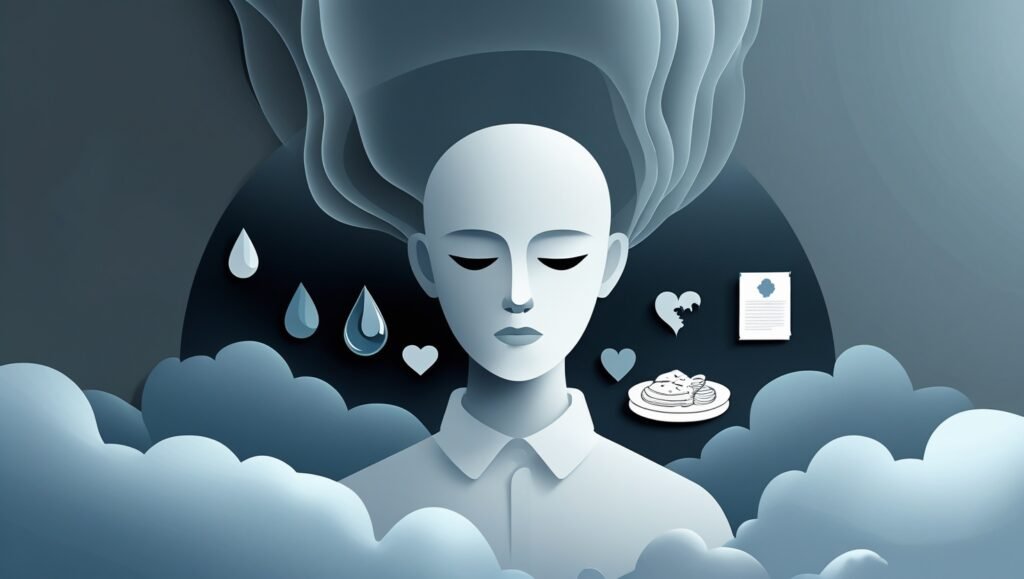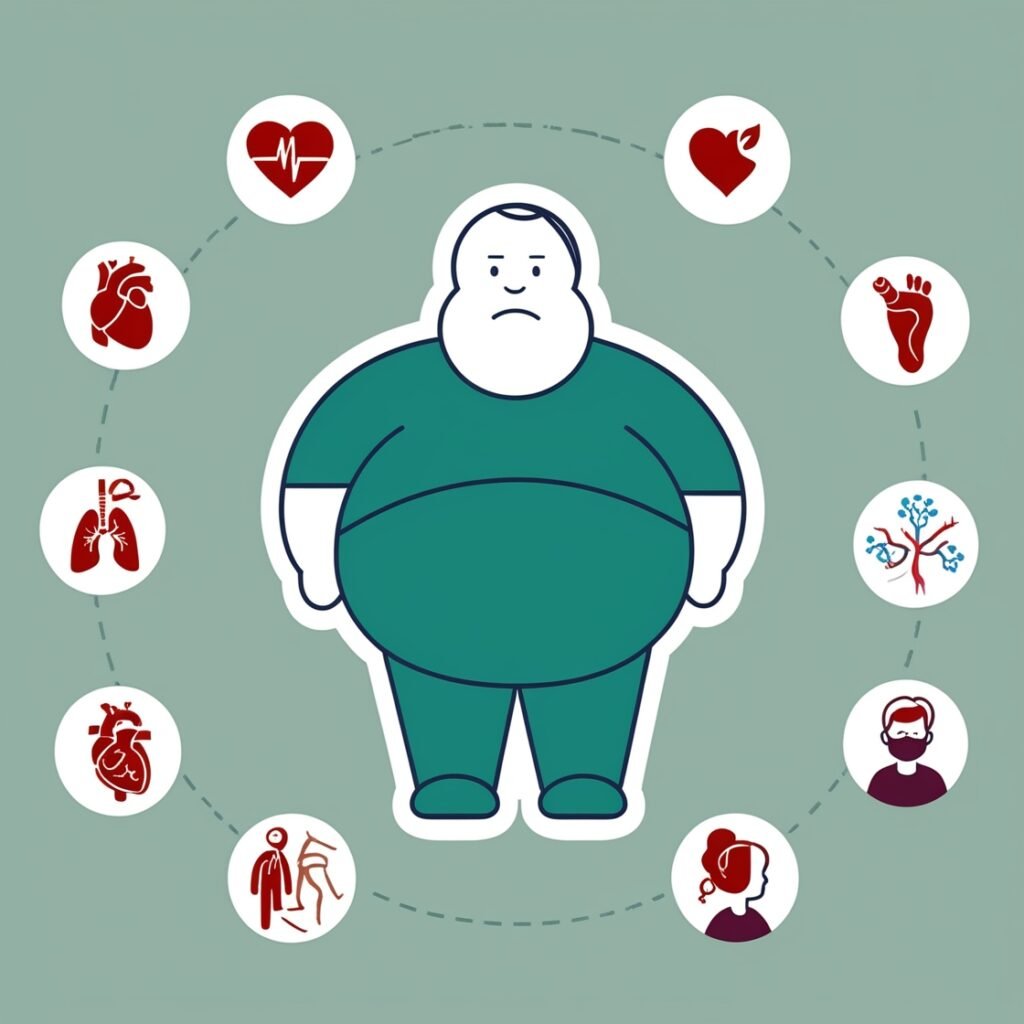Table of Contents
Feeling Overwhelmed? You’re Not Alone
Depression is more than just sadness—it’s a heavy weight that can make even simple tasks feel impossible. Maybe you’ve noticed a loss of interest in things you once loved, or perhaps exhaustion lingers no matter how much you rest. You might wonder, “Why can’t I just snap out of it?” The truth? Depression isn’t a choice, and it’s not something you have to face without support.
In this blog, we’ll explore what depression really feels like, uncover its possible causes, and share practical ways to cope—from small daily habits to professional treatments that can help. Whether you’re struggling yourself or supporting someone who is, knowledge is the first step toward healing. Let’s walk through this together.
Understanding Depression
Depression isn’t just “feeling sad”—it’s a deep, persistent shadow that can color every part of your life. If you’ve ever wondered, “Why do I feel this way?” or “Is this normal?” you’re not alone. Many people struggle to put the experience into words, which can make it even more isolating. So, let’s break it down.
Recognizing the Signs: Emotional and Physical Symptoms
Depression shows up differently for everyone, but some common signs include:
Emotional symptoms:
- A constant heaviness, like you’re moving through fog
- Loss of interest in hobbies or activities you once enjoyed
- Irritability or numbness—sometimes, feeling nothing at all
- Overwhelming guilt or worthlessness, even when logic says otherwise
Physical symptoms:
- Unexplained fatigue, no matter how much you sleep
- Changes in appetite (eating too much or too little)
- Aches, headaches, or digestive issues with no clear cause
- Restlessness or, conversely, feeling “stuck” in slow motion
If these resonate with you, know that your feelings are valid—and more common than you might think.

Debunking Myths: What Depression Is (and Isn’t)
Misconceptions about depression can make it harder to seek help. Let’s set the record straight:
✅ Depression is NOT:
- Just “being lazy” or “weak”
- Something you can “get over” with willpower alone
- A sign that you’re ungrateful or dramatic
✅ Depression IS:
- A real medical condition, like diabetes or high blood pressure
- Often influenced by brain chemistry, genetics, or life circumstances
- Treatable with the right support, whether therapy, lifestyle changes, or medication
Thought to ponder: If you had a broken leg, you wouldn’t blame yourself for not running a marathon. Depression is an injury, too—one that deserves care, not shame.
Have you ever mistaken depression for something else? What was that like for you? (Drop a comment—we’d love to hear from you.)
Common Causes and Triggers of Depression
Depression doesn’t have a single cause—it’s often a mix of factors that pile up over time. If you’ve ever asked yourself, “Why me?” or “Where did this come from?” you’re not alone. Understanding the roots of depression can help you make sense of your experience and find the right path forward.
Life Events and Stressors That Can Lead to Depression
Sometimes, depression is tied to difficult experiences or prolonged stress. Common triggers include:
Major life changes:
- Loss of a loved one, job, or relationship
- Chronic illness or injury (in yourself or someone you care for)
- Financial strain or housing instability
Emotional burdens:
- Childhood trauma or long-term emotional neglect
- Caregiver burnout (constantly supporting others without relief)
- Social isolation or loneliness
Key insight: Even “positive” changes (like a new job or moving) can be stressful enough to trigger depression. Your brain doesn’t distinguish between “good” and “bad” stress—it just feels overwhelmed.
Biological Factors: How Brain Chemistry Plays a Role
Depression isn’t “all in your head” in the way some people dismiss it—it’s literally in your brain. Science shows:
- Chemical imbalances: Low levels of serotonin, dopamine, or norepinephrine (neurotransmitters that regulate mood) can make it harder to feel joy or motivation.
- Genetics: If depression runs in your family, you might be more prone to it—but it’s not a life sentence.
- Chronic inflammation: Emerging research links depression to bodily inflammation, often tied to diet, gut health, or autoimmune conditions.
Myth buster: “If it’s biological, does that mean I can’t overcome it?” Not at all! Just like diabetes, depression can be managed with the right tools—therapy, medication, or lifestyle shifts.
Can you pinpoint a moment or factor that might have contributed to how you’re feeling? (No pressure—sometimes there’s no clear “why,” and that’s okay too.)
In the next section, we’ll explore practical ways to cope, starting with small steps that can make a big difference.
Coping Strategies for Managing Depression
When depression weighs you down, even basic tasks can feel overwhelming. But here’s the good news: you don’t need to “fix” everything at once. Small, consistent actions can create meaningful change. Let’s explore some practical strategies that have helped others—and might help you too.

Daily Habits That Can Help Ease Symptoms
Depression often tricks you into thinking nothing will help, but science shows these daily practices can make a difference:
The 5% Rule:
- Instead of aiming for 100% productivity, try for 5% better than yesterday.
- Example: If showering feels impossible, just wash your face. That counts.
Natural Mood Boosters:
- Sunlight: Even 10 minutes outside can regulate your sleep-wake cycle.
- Movement: A short walk or gentle stretching releases endorphins.
- Staying Hydrated: Dehydration worsens fatigue—keep water nearby.
The “Do-Nothing” Hack:
- If a task feels paralyzing, give yourself permission to do it badly.
- Example: Hate cooking? A sandwich or cereal is still a valid meal.
Remember: Progress isn’t linear. Some days, “getting through” is enough.
Building a Support System: Talking to Loved Ones
Isolation fuels depression, but reaching out can feel terrifying. Try these approaches:
Scripts for When You’re Struggling:
- “I’ve been having a hard time lately. I don’t need advice—just wanted you to know.”
- “Can we [get coffee/watch a show]? I could use some low-key company.”
Types of Support to Consider:
- Practical: Ask a friend to sit with you while you tackle a chore.
- Emotional: Join a free online support group (like NAMI’s forums).
- Professional: Therapists aren’t just for crises—they’re like gym trainers for your mind.
Key Insight: You don’t have to explain or justify your depression. True support starts with “I believe you.”
When Motivation Lags (Which It Will)
Depression isn’t a motivation issue—it’s an energy issue. On tough days:
- Pair Tasks: Combine something hard with something pleasant (e.g., call a friend while folding laundry).
- Externalize Motivation: Use apps like Finch (self-care pet) or Focusmate (body doubling).
- Celebrate Micro-Wins: Text a friend when you complete a small task—they’ll cheer you on.
If you skip a day (or week) of coping strategies, that doesn’t mean they “don’t work.” Depression recovery is like tending a garden—some days you water it, some days you rest. Both are part of the process.
Professional Treatment Options to Consider
Depression can feel like being stuck in a maze with no exit—but you don’t have to navigate it alone. Professional help can be the map that guides you toward brighter days. Whether you’re considering therapy for the first time or exploring new options, understanding your choices empowers you to take that first brave step.

Therapy Approaches: Finding the Right Fit for You
Therapy isn’t one-size-fits-all. Different methods work for different people, and that’s okay. Here are some common types to consider:
Cognitive Behavioral Therapy (CBT):
- How it helps: Identifies negative thought patterns and replaces them with healthier ones.
- Good for: Those who want practical tools to manage daily struggles.
- Example: If you think, “I’m a failure,” CBT helps challenge that belief with evidence.
Interpersonal Therapy (IPT):
- How it helps: Focuses on improving relationships and communication.
- Good for: People whose depression is tied to grief, conflicts, or loneliness.
Mindfulness-Based Therapies (e.g., ACT or MBCT):
- How it helps: Teaches acceptance and living in the present moment.
- Good for: Those who feel “stuck” in their thoughts or emotions.
Pro tip: Many therapists blend approaches. Don’t be afraid to try a few sessions to see if it clicks.
Medication: What to Know and When It Might Help
Medication can be a game-changer for some, but it’s normal to have questions or concerns. Let’s demystify it:
✅ When medication might help:
- If symptoms are severe or interfere with daily functioning.
- If therapy alone hasn’t provided enough relief.
- When there’s a family history of depression (suggesting a biological component).
⚠️ What to keep in mind:
- It’s not a magic pill: Medication works best paired with therapy or lifestyle changes.
- Side effects vary: Some people experience none; others need to adjust dosages or types.
- Patience is key: It can take 4–6 weeks to notice changes.
Myth buster: “Taking medication means I’m weak.”
False. If you had diabetes, you wouldn’t refuse insulin. Depression is a medical condition, too.
Beyond Therapy and Medication: Other Options
- TMS (Transcranial Magnetic Stimulation): A non-invasive procedure for treatment-resistant depression.
- Support Groups: Sometimes, hearing “Me too” from others is healing in itself.
How to Take the First Step
- Talk to your primary care doctor: They can refer you to a therapist or psychiatrist.
- Use directories: Try Psychology Today or Zocdoc to find providers.
- Telehealth options: Apps like BetterHelp or Talkspace offer virtual therapy.
Remember: Seeking help isn’t a last resort—it’s a courageous choice. And if the first therapist or medication isn’t the right fit, that’s normal. Keep going.
Self-Care and Lifestyle Changes for Relief
Depression often convinces us that nothing helps—but science tells a different story. While self-care isn’t a cure, the right daily habits can create a foundation for healing. Think of these changes like gentle waves gradually smoothing rough stones: small, consistent actions that reshape how you feel over time.
The Body-Mind Connection: Nutrition, Movement, and Sleep
Your physical health directly fuels your mental resilience. Try these evidence-backed adjustments:
Food as Fuel:
- Prioritize protein, omega-3s (found in fish, walnuts), and leafy greens—they support brain function.
- Limit processed sugars and carbs, which cause energy crashes that worsen mood swings.
- Pro tip: If cooking feels impossible, keep “no-prep” snacks like nuts or pre-cut veggies handy.
Movement That Meets You Where You Are:
- A 10-minute walk can boost serotonin as effectively as a light antidepressant for some people.
- Yoga or stretching eases physical tension linked to stress.
- Remember: This isn’t about fitness—it’s about feeling slightly more present in your body.
Sleep Hygiene for Restless Minds:
- Dim lights 1 hour before bed; blue light from screens disrupts melatonin.
- Try the “5-4-3-2-1” grounding technique if anxiety keeps you awake: Name 5 things you see, 4 you feel, 3 you hear, 2 you smell, 1 you taste.
Mindfulness and Stress-Reduction Techniques
When depression makes the past feel heavy and the future seem bleak, mindfulness anchors you in the now. Simple practices:
The 90-Second Rule:
- Emotions chemically flood the body for just 90 seconds. Observe the wave without judgment—it will pass.
Nature Therapy:
- Sitting near a window or under a tree lowers cortisol (the stress hormone). No park nearby? Houseplants or nature sounds help too.
Creative Outlets as Emotional Release:
- Doodling, journaling one sentence, or humming a tune can disrupt negative thought loops.
Check mental health tips for more effective ways to help you.
Building a Personalized Toolkit
Not every strategy will resonate—and that’s normal. Try this:
- Track tiny wins: Use a notes app to log one thing each day that felt slightly better (e.g., “Drank water” or “Opened curtains”).
- Pair self-care with habits you already have:
- Brush teeth → Splash face with cold water to reset.
- Check phone → Take three deep breaths first.
3. Embrace “good enough”:
- A messy walk > no walk.
- A snack > skipping meals.
Kind reminder: Self-care isn’t selfish—it’s how you rebuild the energy to engage with life again. Start small, be patient, and know that every effort counts.
When to Seek Immediate Help
Depression can sometimes cross from “I’m struggling” to “I’m in danger” – and knowing that difference could save a life. If you’re reading this while feeling like you’re barely keeping your head above water, pause for a moment. You matter more than you can possibly realize right now.
Warning Signs That Require Urgent Attention
These symptoms mean it’s time to reach out immediately:
- Active suicidal thoughts (not just passive “I wish I wasn’t here” but actual plans or intent)
- Complete inability to care for basic needs (not eating/drinking for days, severe self-neglect)
- Psychotic symptoms (hearing voices, intense paranoia, or detachment from reality)
- Giving away possessions or sudden sense of “peace” after severe depression (may indicate a decision to end one’s life)
What to do right now if this is you:
- Call your local emergency number or suicide hotline (like 988 in the U.S.)
- Go to the nearest ER – you don’t need an appointment
- Tell someone – even if it’s just texting a crisis line
How to Help Someone Else in Crisis
If you’re worried about a loved one:
- Ask directly: “Are you thinking about suicide?” (This doesn’t plant the idea – it creates an opening to help)
- Remove means: If they have access to pills/weapons, help make them inaccessible
- Stay present: Even if you don’t have answers, your presence is powerful
The Truth About Crisis Support
Many people hesitate because:
❌ “I don’t want to be a burden”
✅ You are never a burden – professionals WANT to help
❌ “They’ll lock me up”
✅ Hospitalization is rare – most get outpatient support
❌ “Nothing helps anyway”
✅ Depression lies – relief IS possible
After the Storm Passes
If you’ve survived a crisis before:
- Make a safety plan when you’re stable (list coping strategies, emergency contacts)
- Notice your personal early warning signs (sleep changes, irritability, etc.)
- Remember: Seeking help in crisis is like calling 911 for a broken bone – it’s medical care, not failure
Conclusion: A Message of Hope and Healing

Depression is a heavy burden to carry, but here’s what you need to remember: you were never meant to carry it alone. Whether you’ve just started recognizing the signs in yourself or have been battling this for years, every step you take—no matter how small—is a victory. Healing isn’t about erasing depression overnight; it’s about learning to navigate it with more light, more support, and more self-compassion.
Key Takeaways to Carry With You
- Depression Lies – It tells you you’re broken, hopeless, or unworthy. But those thoughts? They’re symptoms, not truths.
- Help Works – From therapy to small daily habits, relief is possible. You don’t have to white-knuckle your way through this.
- Progress Isn’t Perfect – Some days, just getting out of bed is enough. Other days, you’ll feel stronger. Both are part of the journey.
A Gentle Reminder
If you take nothing else from this article, let it be this: Your pain is valid, but it isn’t permanent. Even when it feels endless, depression can loosen its grip. Maybe not today, maybe not tomorrow—but with time, support, and the right tools, the weight will lighten.
So ask yourself today:
- What’s one small thing I can do to show myself kindness?
- Who’s one person I can reach out to, even just to say, “I’m having a hard time”?
You don’t need to have all the answers right now. Just keep going.
Where to Go From Here
If this resonated with you, consider:
- Bookmarking this page for days when you need a reminder.
- Sharing it with someone who might be struggling silently.
- Taking action—whether that’s scheduling a therapy session, calling a friend, or trying one coping strategy.
You deserve support. You deserve relief. And most of all, you deserve to believe that better days are possible.
References
- American Psychiatric Association. (2013). Diagnostic and statistical manual of mental disorders (5th ed.). https://doi.org/10.1176/appi.books.9780890425596
- National Institute of Mental Health. (2021). Depression. https://www.nimh.nih.gov/health/topics/depression
- World Health Organization. (2021). Depression fact sheet. https://www.who.int/news-room/fact-sheets/detail/depression
- Cuijpers, P., et al. (2020). “Psychological treatment of depression: A meta-analytic database of randomized studies.” BMC Psychiatry, 20(1), 1-16. https://doi.org/10.1186/s12888-020-02912-8
- Harvard Health Publishing. (2019). “What causes depression?” Harvard Medical School. https://www.health.harvard.edu/mind-and-mood/what-causes-depression
- National Alliance on Mental Illness. (2022). Depression. https://www.nami.org/About-Mental-Illness/Mental-Health-Conditions/Depression
- Anxiety and Depression Association of America. (2022). Depression. https://adaa.org/understanding-anxiety/depression
- Centers for Disease Control and Prevention. (2022). Mental health conditions: Depression and anxiety. https://www.cdc.gov/tobacco/campaign/tips/diseases/depression-anxiety.html
- National Suicide Prevention Lifeline. (2022). About the lifeline. https://suicidepreventionlifeline.org
- Jacka, F. N. (2017). Brain changer: The latest cutting-edge science on how diet affects your mental health. Yellow Kite.




